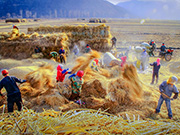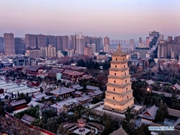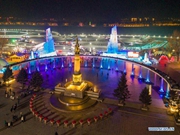

A herdsman checks the automatic drinking system in Otog Banner, north China's Inner Mongolia Autonomous Region, July 28, 2017. Over the past 40 years, technological advances have brought sweeping changes to the vast grasslands of Inner Mongolia Autonomous Region, which occupies more than 12 percent of China's land area. Technologies ranging from automatic feeding and drinking machines to smart fences and remote-controlled irrigation systems have not only made the lives of herdsmen easier but also raised their incomes and freed many people from a life of drudgery. Changes in housing and transportation have also occurred. Houses specially designed by architects for nomads are equipped with thermal insulating walls and a solar heating system. By the end of 2017, the number of private cars in the region surpassed 2.7 million, compared with around 10,000 in 1987. In addition to the material changes, people's mindsets have also changed as well. In history, ethnic minority groups including Mongolians paid very little attention to business. The Internet has brought products from around the country to the grassland and many herders run stores selling dairy products. (Xinhua/Chen Bin)
 |

 Award-winning photos show poverty reduction achievements in NE China's Jilin province
Award-winning photos show poverty reduction achievements in NE China's Jilin province People dance to greet advent of New Year in Ameiqituo Town, Guizhou
People dance to greet advent of New Year in Ameiqituo Town, Guizhou Fire brigade in Shanghai holds group wedding
Fire brigade in Shanghai holds group wedding Tourists enjoy ice sculptures in Datan Town, north China
Tourists enjoy ice sculptures in Datan Town, north China Sunset scenery of Dayan Pagoda in Xi'an
Sunset scenery of Dayan Pagoda in Xi'an Tourists have fun at scenic spot in Nanlong Town, NW China
Tourists have fun at scenic spot in Nanlong Town, NW China Harbin attracts tourists by making best use of ice in winter
Harbin attracts tourists by making best use of ice in winter In pics: FIS Alpine Ski Women's World Cup Slalom
In pics: FIS Alpine Ski Women's World Cup Slalom Black-necked cranes rest at reservoir in Lhunzhub County, Lhasa
Black-necked cranes rest at reservoir in Lhunzhub County, Lhasa China's FAST telescope will be available to foreign scientists in April
China's FAST telescope will be available to foreign scientists in April